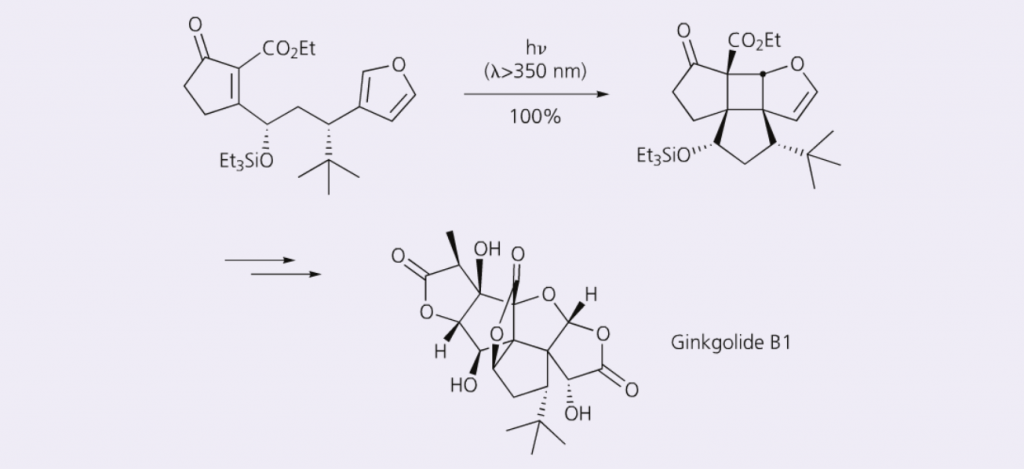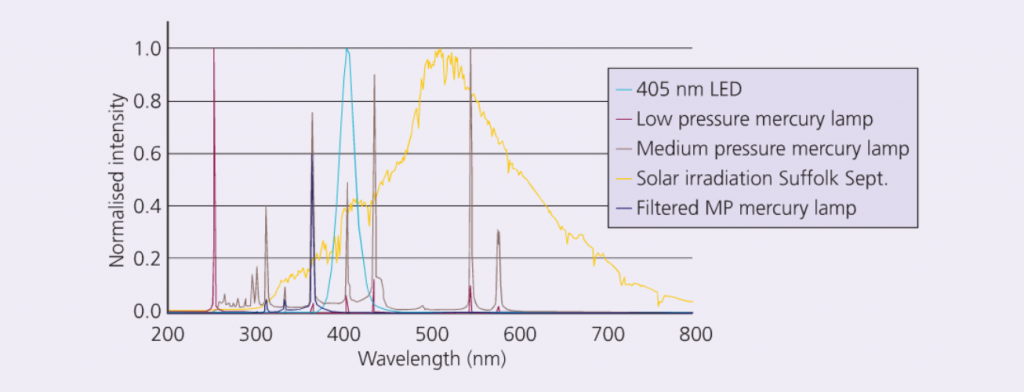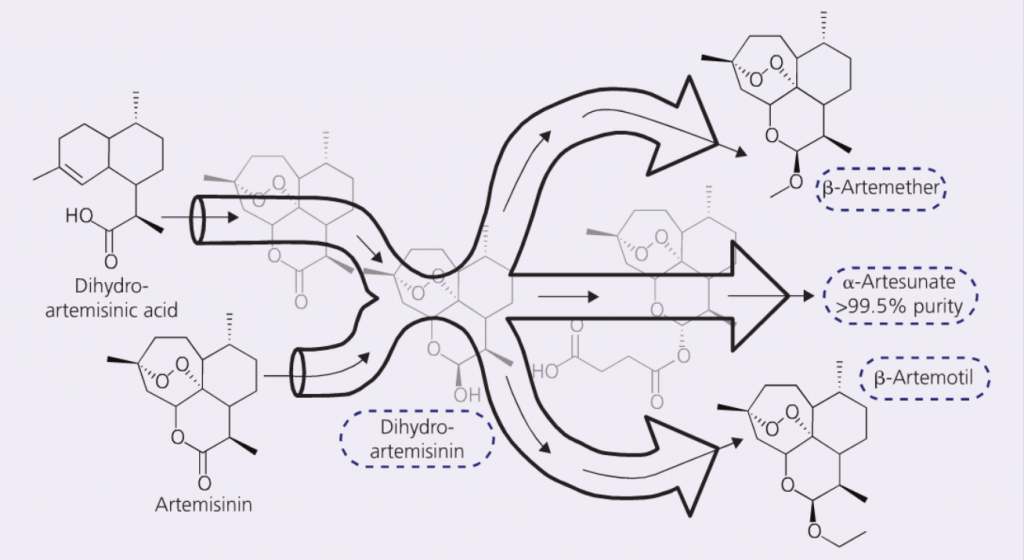Date: 1 November 2014 | Category: News
Photochemistry has incredible potential despite remaining a much under-utilised technique with synthetic chemists, says Duncan Guthrie of Vapourtec
A look at the current literature published in Chemical Abstracts shows that only about 1% of published papers feature photochemistry. Clearly, photochemical reactions, those that involve the absorption of light by atoms and molecules, are used far less than perhaps they should be.
Photochemical reactions deliver a triple whammy in the form of the number of reaction pathways. Not only ground state chemistry but also singlet and triplet states can be accessed. It is also true that many reactions in the excited state have no ground-state counterpart.
At present, photoexcitation is experiencing a resurgence of interest due to its ability to provide novel structures and alternative, greener synthetic routes. Indeed synthetic organic photochemistry offers a powerful tool for the conversion of simple structures into complex products that can have far-reaching, positive effects for industry, pharmaceuticals and research.
This article will outline a few of the most common types of photochemical reaction and analyse the key features of a reactor, considering the light sources currently available. Finally, it will showcase just a few of the many real world applications for photochemistry.
Photochemistry – Historical background
Photochemistry offers a diverse and wide range of reactions that can give chemists interesting and often shorter reaction routes than those available via traditional ground state reactions. I firmly believe that every synthetic chemistry lab should have the capabilities and technologies to deliver photochemistry. It does not have to be the domain of the dedicated, expert user.
At the turn of the 20th century, photochemistry was barely developed and the few known photochemical reactions were not well understood. However, the potential was clearly envisaged by some visionaries, notably Giacomo Ciamici, who declared in 1912:
“On the arid lands there will spring up industrial colonies without smoke and without smokestacks; forests of glass tubes will extend over the planes and glass buildings will rise everywhere; inside of these will take place the photochemical processes that hitherto have been the guarded secret of plants but will have been mastered by human industry which will know how to make them bear even more abundant fruit than nature, for nature is not in a hurry and mankind is.”1
Over the last couple of decades, the interest in and demand for sustainable and environmentally friendly technologies has led to an increased awareness of organic photochemistry as a clean, reagent-less application.2 Parallel with this has been growing awareness and take-up of continuous flow chemistry. A flow chemistry approach to photochemistry only increases its productivity, flexibility and potential over the traditional batch process.
The two are indeed excellent bedfellows with many advantages over conventional batch applications, such as consistent light penetration, controlled exposure times, precise temperature control, easy scalability and the continuous removal of photochemical products from the irradiated area. These features will typically result in higher conversions and yields, improved selectivity, enhanced energy efficiency and a reduction in waste due to lower solvent volumes.
Photochemistry Applications
Whilst photochemistry can deliver a broad range of reactions, including photochemical oxidation and reductions, photodecarboxylations, photochemically induced cyanations, chlorination, enolisations, we generally tend to split them into five distinct types, as described below. These account for the vast majority of photochemical reactions.
Photocycloadditions
The most common photocycloaddition reaction is the [2+2] reaction of α,β-unsaturated ketones or esters to alkenes, alkynes or allenes leading to cyclobutanes. Complex structures can be accessed in one step without having to use toxic or expensive reagents. This approach has been used in the synthesis of a number of natural products such as Gingolide B1 and Littoralisone (Figure 1).3

Figure 1 – Photocycloaddition reactions to natural products
Photochemical rearrangements
Photochemical rearrangements have been applied to the synthesis of complex structure from relatively simple structures. They fall into a number of catagories and reaction types including E-Z isomerisation, di-π-methane rearrangements, photodeconjugation and Wolff rearrangements via ketenes. The photochemical transformation of methyl coumalate to the pyrone via a 4π electrocyclisation was an important process in the formation of the cyclobutane structure key in the total synthesis of a range of piperarborenines (Figure 2).4

Figure 2 – Photochemical addition in the synthesis of piperarborenines
Photochemical cyclisations
Photochemical cyclisations are defined as pericylicyclisations or Norris-Yang type cyclisations. The investigation of pericylisations, in particular their stereoselectivity, contributed to the development of the Woodward-Hoffmann rules for concerted reactions.
Pericylcliations have been shown for the synthesis of both carbocyclic and heterocyclic compounds.5 The synthesis of (+)-narciclasine and (+)-pancratistatin (Figure 3), both of which contain anti-tumour activity, use the cyclisation of a benzamide derivative as a key step.6
An example of a synthetically useful Norrish Type II reaction can be found early in the total synthesis of the biologically active cardenolide ouabagenin. The optimised conditions minimise side reactions, such as the competing Norrish Type I pathway, and give the desired intermediate in good yield on a multi-gram scale.7
 Figure 3 – Pancratistain (left) and narciclasine (right)
Figure 3 – Pancratistain (left) and narciclasine (right)
Photooxygenation reactions
Photooxygenation is a reaction involving oxygen. Interest in photooxygenation was initiated with the findings of Oscar Raab. He discovered in 1900 that the combination of light, oxygen and photosensitisers is highly toxic to cells with early studies focusing on oxidative damage to DNA and amino acids.8,9
More recent research has led to the application of photooxygenation in organic synthesis and photodynamic therapy. These types of reactions are initiated by a photosensitiser, a molecule that enters an excited state when exposed to light of a specific wavelength. This agitated molecule then reacts with either a substrate or ground state molecular oxygen to initiate a cascade of energy transfers that results in an oxygenated molecule.
The photocatalysis family of reactions, finally, involves the presence of a catalyst to speed up the process. Photocatalytic activity is dictated by the ability of the catalyst to build electron-hole pairs, which in turn generate free radicals, such as hydroxyl radicals, that are able to undergo secondary reactions.
 Figure 4 – Total synthesis of ouabagenin
Figure 4 – Total synthesis of ouabagenin
The reactor
A number of key features are required for a photochemical reactor, beginning with a light source that outputs at wavelengths of interest to the reaction. Options here include low-, mediumand high-pressure mercury lamps, xenon lamps, LEDs and the sun itself. If a light source outputs a broad range of wavelengths, optical filters can be used to pass only the required wavelengths selectively into the reaction.
A cooling system is a prerequisite to control the temperature of the lamp during and immediately after usage. A parallel cooling system may also be required for the filters if they form part of the experiment at hand. Reactors also require a reaction vessel to contain the relevant reactants. They can be either the traditional batch type or configured for a continuous, flow process of reagents.
A way of managing the temperature of the reagents contained in the reactor is also vital. Taken together with the cooling systems, that means a lot of temperature control in a small space.
Finally a reflector feature that reflects UV light passing through the reagents and back into the reactor is another key requirement to increase efficiency. Ideally this should selectively absorb the unwanted longer wavelength radiation, or heat, whilst reflecting the desirable shorter wavelength UV radiation. Controlling absorption and reflection is a critical part of the very latest reactors and this aspect requires a lot of R&D by companies involved with manufacturing such precise systems and technologies.
Source of light
The vast majority of photochemical reactions involve light sources operating between wavelengths of 150 and 500 nm. As a point of contrast, solar irradiation on the Earth’s surface delivers a much wider wavelength range from 300 up to 2,500 nm.
Low-pressure mercury lamps of the fluorescent tube variety have proven to be efficient light sources, if relatively limited in potential. They emit the vast majority of their energy at two distinct wavelengths: 184 and 254 nm.
The most commonly used light sources within photochemical reactors and reactions are undoubtedly medium-pressure mercury lights, these output a continuum between 210 and 240 nm, then a number of output bands up to 600 nm. LEDs hold the key, however, to increasing the efficiency and scope of photochemistry. Ongoing LED innovation is paving the way for ever increasing possibilities.
LEDs are now available in high-power and efficient modules at discrete wavelengths between 365 and 900 nm, with output powers ranging from 500 mW up to 10 Watts/module and efficiencies up to 40% (Watts out/Watts in). Shorter wavelength, deep UV LEDs are currently available in lower power modules from 265 to 365 nm with output power below 100 mW.
Using light emitting diodes for photochemistry
The pace of LEDs development has been rapid and manufacturers are recognising the potential. Applications in disinfection, sensing and polymer curing are driving developments of efficient, mercury-free deep UV LEDs in the range 250-350 nm. By way of an example, Nichia in Japan recently reported testing of 255, 280 and 310 nm LEDs that are designed for high current applications, giving output powers of 45, 93 and 66 mW respectively.10
So the future is LEDs when it comes to photochemistry especially so when a continuous flow process is adopted. A combination of this innovation and approach represents, in my view, a very exciting opportunity to improve the efficiency and safety of large-scale photochemical processes.
The advantages of LEDs over traditional mercury lamps are many. For a start, the output of an LED can be targeted over a small range of wavelengths, improving the selectivity of the reaction and reducing the heating effect of the radiant output when compared to medium pressure mercury lamps.
LEDs can also be much more efficient. For example, in a photochemical reaction process requiring irradiation in the range 390-420 nm, a typical medium pressure mercury lamp will provide 2.5 watts of output power and 100 watts of input power, whereas a light source assembled from modern 405 nm LEDs will typically provide 15 watts of output power and 100 watts of input power in the target wavelength range, using just one sixth of the power in providing the same photon flux.
The safety profile of the photochemical process can be significantly improved because the surface temperatures of the LEDs will be <80ºC, compared with the medium-pressure mercury lamp at >200ºC. Additionally, the array of LEDs would typically operate at less than 60 volts DC, compared to mercury lamps that require >5,000 to strike the arc (Figure 5).
 Figure 5 – Normalised output of common photochemical light source
Figure 5 – Normalised output of common photochemical light source
Real world photochemistry applications
Recent photochemical breakthroughs that impact on the real world include improved efficiency in the production of anti-malaria drug artemisinin. This WHO-approved sesquiterpene endoperoxide artemisinin, made by Roche and DSM, is the most effective treatment response for in tackling the protozoan parasite that causes malaria, Plasmodium Falciparum. However reliance on the cultivated plant from which it is extracted, sweet wormwood (Artemisia Annua), restricts supply and drives up costs.
Continuous flow photosynthesis of Artemisinin
In early 2012 scientists at the laboratory of Peter Seeberger and François Lévesque at the Max Planck Institute in Potsdam, Germany, developed a new synthesis route that makes it possible for artemisinin to be manufactured in sufficient quantity and at an affordable price. Using a flow chemistry system and a photoreactor developed at the institute, researchers were able to synthesise artemisinin from the more easily obtainable artemisinic acid. This is a much less complex molecule, which can be extracted from the same plant in higher yields or produced in engineered yeast. It represented a good starting point for the synthetic production of artemisinin.
The conversion of artemisinic acid to artemisinin was a major challenge. Seeberger’s team overcame this as a direct result of a continuous photochemical transformation that involved a singlet-oxygen induced ene reaction and the addition of triplet oxygen (Figure 6). The latter triggered a reaction cascade that incorporated the essential endoperoxide group.11 This technically simple, efficient and inexpensive synthesis is readily scalable due the continuous flow process with isolation and intermediate purification not required.
 Figure 6 – Photochemical route to artemisin
Figure 6 – Photochemical route to artemisin
Synthesis of vitamin D3
The synthesis of vitamin D3, from 7-dehydrocholesterol is very important in human medicine and nutritional supplements. The industrial synthesis of vitamin D is a perfect example of replicating a naturally occurring biosynthesis.12 The UV irradiation of 7-dehydrocholesterol mimics the transformation that takes place in the body with UV-B irradiation to produce cholecalciferol.
Vitamin D2 (ergocaliferol) is produced industrially involving a similar strategy but using ergosterol as the precursor. In this example, the photochemical process is key as the reaction does not proceed without UV light activation. When 7-dehydrocholesterol is exposed to light, the cyclohexadiene ring is opened to the triene, previtamin D3. On gently heating, this isomerises to vitamin D3 via a sigmatropic 1,7-hydrogen shift.
Two major producers in India, Dishman and Fermenta Biotech, are shortly to increase their combined capacity to about 24 tonnes/year, in the expectation of 6-10%/year growth. Meanwhile, consumer awareness around D3 has led many food products-makers to include the vitamin in their offerings. Malted food and beverage-maker Cadbury’s recently re-formulated its product Bournvita to include vitamin D3.
Conclusion
The key trends that will lead to increased demand for, and interest in, photochemistry revolve around the continuing use of flow chemistry processes, that deliver efficiency, control and scalability unmatched by batch chemistry, as well as ongoing innovation in reactor technology. In particular, increased usage of ever improving LED offers many benefits over traditional mercury lamps and will continue to shine a light on an incredible potential future for photochemistry.
References
- 1. G. Ciamician, Science 1912, 36, 385
- 2. J.P. Knowles, L.D. Elliott & K.I. Booker-Milburn Beilstein J. Org. Chem. 2012 8, 2025-2052
- 3. M.T Crimmins, J.M. Pace, P.G. Nantermet, A.S. Kim-Meade, J.B. Tomas, S.H. Watterson & A.S. Wagman, J. Am. Chem. Soc. 2000, 122, 8453
- 4. W.R. Gutekunst & P.S. Baran J. Am. Chem Soc., 2011, 133 (47), 19076-19079
- 5. R.B. Woodward & R. Hoffmann, Angew. Chem., Int. Ed. 1969, 8, 781
- 6. J.H. Rigby, U.S.M. Maharoof & M.E. Mateo, J. Am. Chem. Soc. 2000, 122, 6624
- 7. H. Renata, Q. Zhou & P.S. Baran, Science, 339 (6115), 59-63
- 8. C.S. Foote Science (AAAS), 162 (3857), 963-970
- 9. M.R. Iesce et al. Curr. Org. Chem. 2005 9 (2), 109-139
- 10. A. Fujioka et al., Semicond. Sci. Technol. 2014 29, 084005
- 11. F. Levesque & P.H. Seeberger, Angew. Chem. Int. Ed. 2015, 51, 1-5
- 12. M.F. Holick, Journal of Nutrition 2005, 135 (11), 2739S-48S
